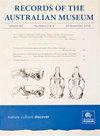支持承认Kaputar Rock Skink的遗传证据,Kaputar岩石Skink是新南威尔士州最受限制的脊椎动物之一
IF 0.8
4区 生物学
Q4 ZOOLOGY
引用次数: 1
摘要
Kaputar Rock Skink是一种形态独特的埃及种群,仅分布在新南威尔士州北部的Nandewar山脉,几十年来人们一直知道它的存在。然而,在科学文献中尚未发表对该分类群的全面描述或诊断,其独特性在很大程度上是假设的。作为调查南德瓦尔山脉动物种群遗传分化的研究的一部分,对卡普塔尔岩石石龙子和东澳大利亚埃及纹虫组物种进行了比较。结果表明,Kaputar Rock Skink是一个独特的遗传谱系,显示出与其他埃及物种的物种水平差异。实地研究表明,卡普塔尔岩石蜥蜴仅限于海拔1000米以上的岩石栖息地的极窄地带,并且只占据悬崖边缘或大量露头岩石区域的撤退和庇护场所。它现在似乎是一种适应寒冷的物种,受生态位保守性的限制,只能在高海拔的栖息地生存。实地研究表明,在南德瓦尔山脉的山顶地区,合适的栖息地非常有限,使其容易受到几个潜在威胁过程的影响,包括人为气候变化。Contundo roomi这个名字是1985年由Wells & Wellington为Kaputar Rock Skink命名的,我们推荐Egernia roomi (Wells & Wellington, 1985)作为Kaputar Rock Skink的名字。本文章由计算机程序翻译,如有差异,请以英文原文为准。
Genetic evidence in support of the recognition of the Kaputar Rock Skink, one of New South Wales’ most range-restricted vertebrate species
The existence of the Kaputar Rock Skink, a morphologically distinct Egernia population restricted to the Nandewar Ranges in northern New South Wales, has been known for decades. However, no comprehensive description or diagnosis of the taxon has been published in the scientific literature, and its distinctiveness largely assumed. As part of a study investigating the genetic differentiation of faunal populations on the Nandewar Range, comparisons between the Kaputar Rock Skink and east Australian Egernia striolata-group species were undertaken. The results indicate that the Kaputar Rock Skink is a distinct genetic lineage, showing species-level divergence from other Egernia species. Field studies suggest the Kaputar Rock Skink is restricted to an extremely narrow band of rock habitat above 1000 m or more in elevation, and only occupies retreat and sheltering sites near cliff edges or in areas of extensive outcropping rock. It now appears to be a cool-adapted species constrained to high elevation habitat by niche conservatism. Field studies suggest the availability of suitable habitat on the summit areas of the Nandewar Ranges is highly limited, making it vulnerable to several potentially threatening processes, including anthropogenic climate change. The name Contundo roomi was erected for the Kaputar Rock Skink by Wells & Wellington in 1985, and we recommend Egernia roomi (Wells & Wellington, 1985) as the name for the Kaputar Rock Skink.
求助全文
通过发布文献求助,成功后即可免费获取论文全文。
去求助
来源期刊
CiteScore
0.90
自引率
0.00%
发文量
9
审稿时长
>12 weeks
期刊介绍:
Records of the Australian Museum, volume 62 was published in 2010, volume 63 in 2011. Monographic works of particular significance are published irregularly as Records of the Australian Museum, Supplements (ISSN 0812-7387).

 求助内容:
求助内容: 应助结果提醒方式:
应助结果提醒方式:


